| About Bolt Products | Bolt Products Homepage | Bolting Information | Catalogue |
| Sustainable Bolting and Bolt Removal | Sustainable Bolting The cliffs we climb on are a finite resource and it is up to us to preserve them for future generations. The rusting remnants of previous bolting eras are a common and unsightly feature of many older cliffs, the failure of climbers to remove old bolts and instead place yet another nearby is slowly leading to a situation where there are no more sound placements to be found, while the spread of rusting metalwork makes climbers an easy target in sensitive areas. We at Bolt Products have identified three areas where responsible route developers can help to preserve our climbing heritage:- Longer bolt life Removability Reduced visual impact |
| Strength and Tests | |
| Bolt Selection | |
| Orders, Delivery and Discounts | |
| Protection Bolts | |
| Sea Water Series | |
| Single Point Lower-offs | |
| Chain Extenders | |
| Chain Sets | |
| Stainless Steel Pitons | |
| Maillons, Rings and Chain | |
| Via Ferrata Equipment | |
| Glue and glue guns | |
| Accesories | |
| Service and support | |
| Terms and conditions |
Longer Bolt Life
Many routes are on their fifth generation of bolts and while the widespread use nowadays of stainless steel bolts will slow down the pace of replacement the problem of what to do in 50 or 100 years is a serious one. Poorly placed bolts, unsuitable materials and misuse by climbers are all issues which have led to wholesale bolt replacement.
The use of stainless steel bolts, correctly treated to reduce corrosion and carefully glued in place will enormously extend the lifespan of the protection fitted, while for lower-offs the issue of wear can only be adressed by making them replaceable or of thicker material. It is quite obvious from visits to most popular cliffs that efforts to educate climbers to use their own equipment for top roping or to abseil from routes have failed and climbers will continue to use bolts directly threaded through.
For this reason we offer all our lower-offs and rings in 12mm rod to give hopefully decades of life.
Removability
No matter how strong or thick bolts are made the issue of replacement will sooner or later arise and to avoid adding to the number of holes and "dead" bolts in the cliff the old bolts should be removed and the hole re-used, ideally this will be then repeated ad infinitum.
We have developed a special core drilling technique allowing removel of old bolts and a new bolt to be glued in. This is the only long term way to ensure the continued use of the rock.
Reduced Visual Impact
In many areas today climbers are increasingly facing access difficulties. One aspect which is often used by opposing groups is the visual impact of bolting on the cliffs. Thankfully the days of rust streaks from mild steel bolts seem to be behind us but the increased use of bolt-ins with their large stainless hangers gives plenty of ammunition to our critics.
One solution is to colour treat the hangers to disguise them, the simple application of a suitable spray paint can make bolts unobtrusive, even to the extent that the climbers cannot see them! Another way, or better still combined with painting, is to make the bolt head smaller and rounded to reduce reflection.
The Bolt Broducts range of bent-rod bolts and hangers have the lowest visual impact of any on the market!
![]()
Bolt Removal.
A number of people suggest cutting bolts off flush with the rock and/or driving them below the surface then disguising them with cement. This is of course a very short sighted way of doing things, the problem of placing the next bolt too near the old hole is made more difficult.
There are quite a number of possible ways of removing existing bolts. it very much depends on the type of bolt and it´s condition:-
Drilling out- drilling down the centre of a bolt is an almost hopeless task, if they are stainless they will destroy drill bits and a lot of older steel bolts have hardened parts in them. From experience I can say this is not a route to explore. The other, more popular way is to drill a number of holes in the rock around the bolt until it is loose and can be removed. This generally is hard on drill bits and regrettably leaves a huge ragged hole which has to be filled.
Pulling- if you have access to a suitable puller and the bolts are in good condition then this can work well, though the tendency is for them to break off leaving one not much further forwards. The other problem is pulling may cause the rock to break out on the surface which is usually unsightly especially with glue-ins though heating the bolt for a while will soften the glue in this area and reduce this problem (see below)
Melting out- some glue-in bolts were fitted with resins which can be heated and softened allowing them to be easily pulled, however most construction adhesives use cement powder as the filler and this has usually cured preventing softening. The bolt doesn´t need to be very hot, around 200°C will do, in fact if you heat it too much will usually snap off very easily but it takes a long time for the heat to get into the glue, especially for stainless steel which has a poor conductivity. We cut an old can as a heat/wind shield to suit a hand-held gas burner and slowly warm the bolt, it takes quite a time for the heat to penetrate,10 minutes or more. Then with a suitable wrecking bar try to pull it, if it doesn´t come then warm it some more. Best used in combination with a puller or very long wrecking bar.
This seems to work better with some adhesives as others, previously I used an epoxy based system which was fairly easy to remove but others have reported that with polyester this doesn´t work. I recently installed a bolt with polyester in a granite test block and then cut into it to give access for a temperature probe. The glue softened and became crumbly at around 92°C and after 10 mins heating had broken down for half the depth (40mm) however the base of the bolt was still only at 57°C after 20mins. Obviously the rate of heat transfer is going to depend on the thermal conductivity of the glue and the rock around but it will be reasonable to think that if you can´t pull the bolt after 10mins then you will need to heat it for a very long time.
Core drilling- this uses a hollow, thin (ca 2mm) walled diamond tipped drill which drills the rock from around the bolt itself and leaves a clean hole. There are two sorts of these drills, the commoner ones have diamond dust electroplated onto the drill, these are like the cheap tile hole-saws you can buy in a DIY shop. Much more robust and faster cutting are ones with orientated diamonds in a bronze sintered matrix, these have much longer life and cut faster.Like most things in life you get what you pay for and so we buy the highest quality drills on the market from the U.S.A. Struggling with blunt drills half way up a cliff is not my idea of a good day out!
Getting drills with suitable dimensions to fit over normal bolts is difficult but the sizes we stock covers 10, 12 and 16 (5/8") bolts.
These drills are designed for use with watercooling using a portable pressure system. We use a 5l garden water sprayer which pressurises to 3 bar adapted to feed to the drill tip. The more normal water pressure feed swivel adaptor for the drill is really only suitable if you have a mains water supply. If you drill dry the drill will overheat and be destroyed and anyway cuts very slowly so the cooling is essential.
As you drill with firm, even pressure, you need to occasionally pull the drill back to clean the hole and tip. To drill the example below, a 10mm bolt 80mm deep in granite took 4 minutes and 1,5l of water.
Diamond drills leave an incredibly smooth hole unsuitable for glueing and before you fit a new bolt you will need to drill out, either to the appropriate size for the bolt or just to roughen the surface. (the drills are Imperial dimensioned)
And before you ask, yes they are expensive but unlike any other method I know of they do the job. Lifespan under optimum conditions is quoted at over 700 holes but I will be satisfied if I can get 300.
This is what the setup we use looks like:-
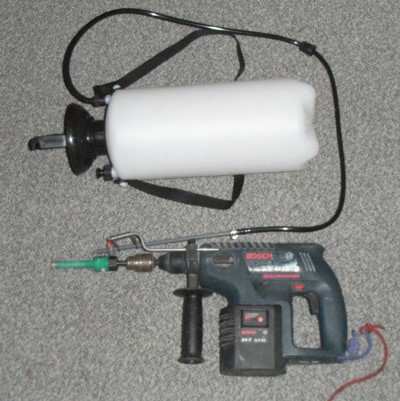
The drills are available with an adaptor for 3/8" or 1/2" standard chucks which we use with a SDS adaptor. The 5l garden spray has the lance removed and is fitted with a fine water jet nozzle and tap which is mounted on the drill where the depth guage would normally fit.
And this is how it works:-
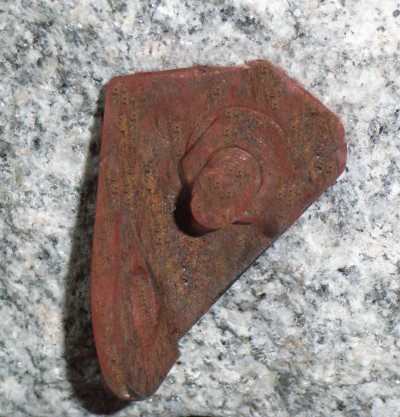
The sort of quality bolting one comes across

Using a b attery powered angle grinder, first cut the nut off or usually you can snap the bolt by overtightening the nut.
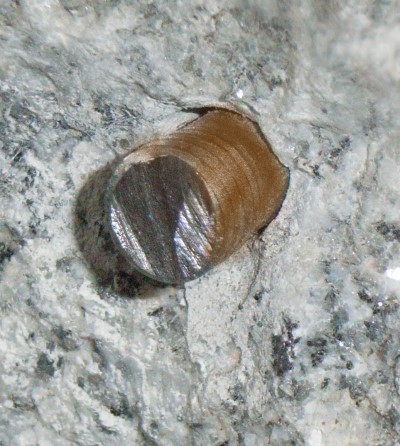
Leaving a short stub.
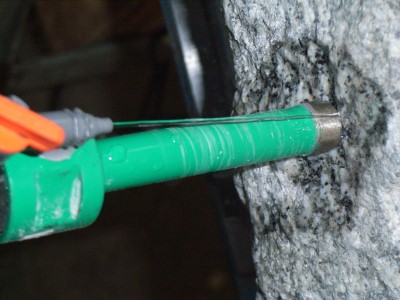
Locate the drill over the stub and turn on the water, positioning the jet to hit the drill tip and start drilling.
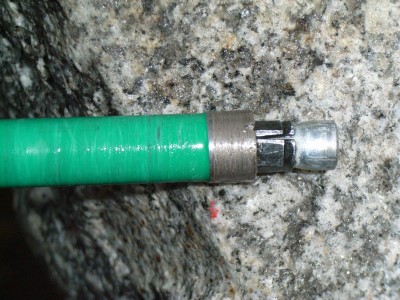
And the bolt is drilled free and comes out like this.
We import a range of sizes of these to cover the common bolt sizes, they are to be found in our catalogue under Accesories along with the cooling system. We may also in future operate a hire service for these;- if you are planning to re-equip a cliff with our bolts they would be available for hire along with a battery powered angle grinder for hanger or eye removal . Please contact us for details and prices.
![]()